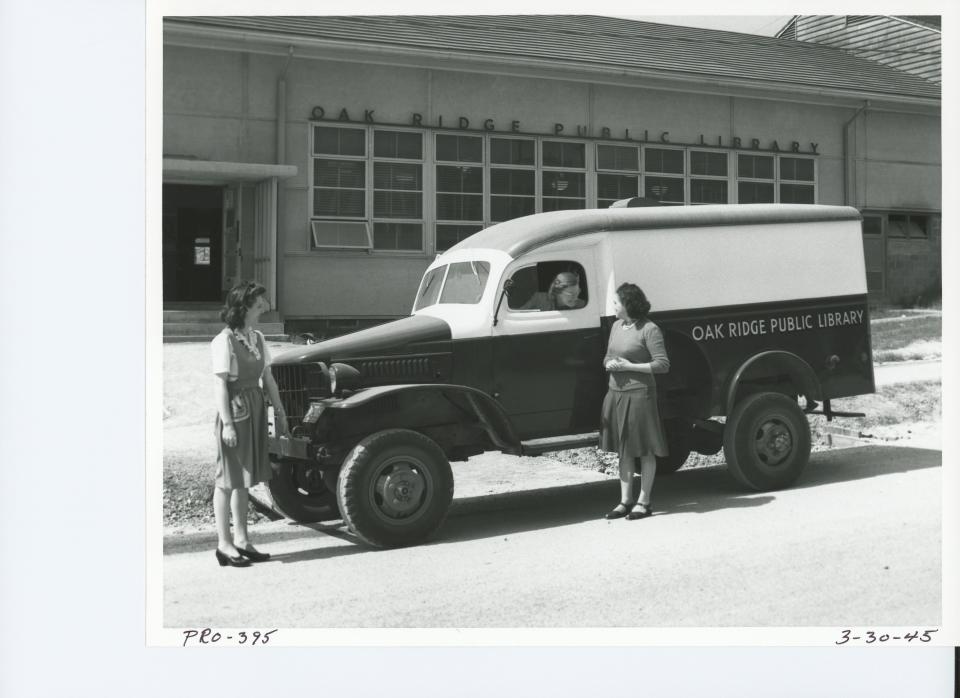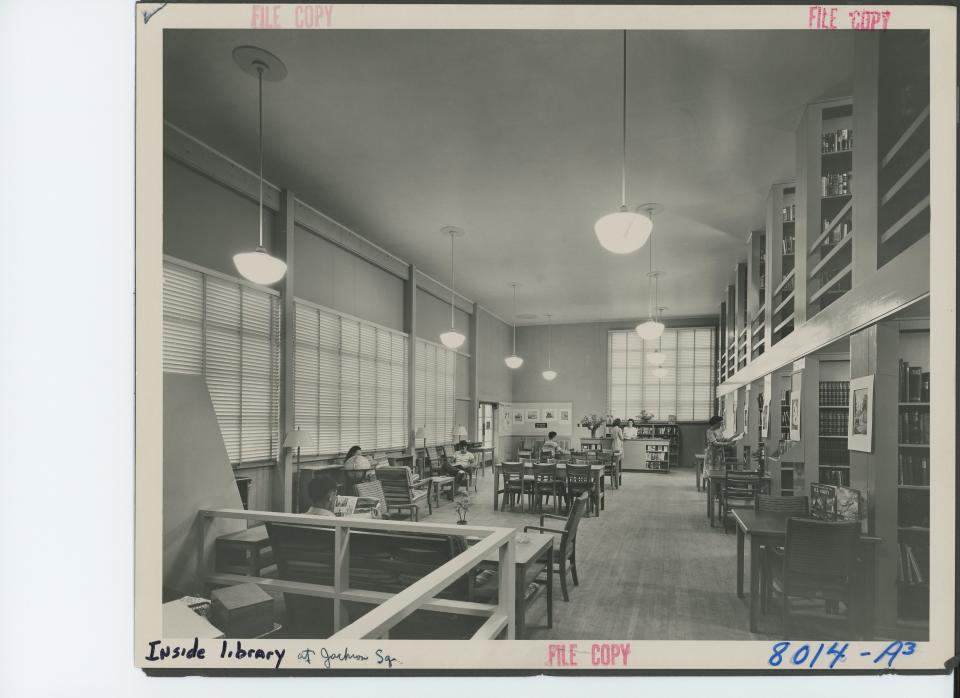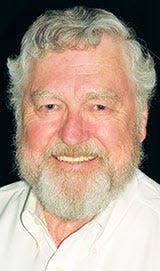Turning 78: The Oak Ridge Public Library
Mike Stallo, research librarian, my fellow historian, and a good friend brings us a story about our library as a part of celebrating 78 years of continuous operation. Significant improvements have been seen over the years and our library is one we can be proud of. Enjoy looking back with Mike.

***
Oak Ridge Public Library turns 78 years old this year. In honor of that, I would like to tell you about our first librarian Elizabeth Edwards.
Due to the nature of wartime conditions in World War II, including sudden relocation and temporary employment, the first citizens of Oak Ridge had not carried many books with them. This quickly created a high demand for books and magazines. In late November of 1943, the leaders of the town began to try to distribute reading materials to the townspeople. It started with a simple magazine redistribution program. Citizens had been encouraged to donate magazines as they finished reading them. A drop-off point was designated for people to leave their donations, then Boy Scouts would collect them and deliver them to dormitories, hospitals, and other common areas in town.
Around this same time, residents were offered an opportunity to subscribe to The Chattanooga Times newspaper and The Sentinel, also published in Chattanooga (not to be confused with the Knoxville News Sentinel). The Periodical Services Bureau acted as a go between for people to subscribe to various newspapers and other periodicals. This was done in part for security reasons, to be able to control the types of information coming into town.
Early Town Council meeting minutes mention the Library Committee and their plans to establish a library. The library project was aligned under the Recreation and Welfare Department. In keeping with the general sense of urgency of the Manhattan Project, things moved very quickly. Once the decision was made to hire a librarian, it took less than a month for Elizabeth Edwards to be chosen as the Head Librarian.

Elizabeth Edwards’ career as a librarian spanned nearly 45 years. She was not afraid to take on a challenge and was willing to relocate on short notice. Edwards was born in Chattanooga, Tennessee, in 1907, where she grew up and attended college at Chattanooga University, which later became the University of Tennessee at Chattanooga. She got her degree in 1927 and entered the apprentice program at the Chattanooga Public Library in 1928.

She moved to New York to continue her training in library science at Columbia University. She completed studies at Columbia and returned to Chattanooga to work as the Head Cataloger for a year. Afterward, she returned to the New York library system, working at several different branches from 1931-1944, including the Queens Borough Public Library, and Kingsbridge Branch of the NYC Public library just before coming to Oak Ridge to be our first librarian.

In 1944, Elizabeth Edwards and her mother made the move to 102 Union Road in Oak Ridge. The house was decorated with items from their travels to Italy, France, and England. Her father had been a prominent jeweler in Chattanooga, and the family had taken many trips abroad before his passing in 1925. Passport records indicate that she traveled overseas on her own several times as well. The house was also home to a top-of-the-line sewing machine on which Elizabeth and her mother, both talented seamstresses, made all their own clothes.
Working at a large metropolitan library like Queens, New York, gave Edwards experience managing a busy library with a high circulation rate. Surprisingly, the pace of activity in Oak Ridge surpassed that of Queens. Oak Ridge’s population hit its highest level in May of 1945 with just over 75,000 living here, the same year Queens had a population of 61,000. The library, like the rest of the town, was built with a wartime sense of urgency, and Elizabeth Edwards had to develop this new library from the ground up.
Shortly after arriving, Edwards began writing a column for the local newspaper, the Oak Ridge Journal. The column was called Bookworm Club and it was used to report on the happenings of the library as it was developing, and later to announce the arrival of new materials to the library. While still in New York, Edwards had ordered several thousand books to be delivered to Oak Ridge. The demand for books was high, and prior to her arrival, the Library Committee had begun asking for book donations from private citizens. Edwards also called for volunteers to help set up the library. Girl Scouts assisted with shelf labels, as well as unpacking and shelving books.
The library opened its doors in late May of 1944 and was fully open for checking out books by June 5, 1944.The first library was located on the corner of Kentucky and Tennessee avenues. The number of books in stock on opening day was about 1,700, most of them donations from citizens, but by August of 1945 it had grown to nearly 10,000. It was still a small collection for a town of 75,000, but nonetheless very impressive considering the circumstances and wartime funding limitations. By 1948, the holdings would be right at 35,000 titles.
While at Oak Ridge, Elizabeth Edwards also started the mobile book program, which helped to get the books out to people who couldn’t easily get to the library. Not everyone had cars, and public transportation could be hectic. In April 1945, the Traveling Library began using a converted Army jeep to haul the books. Typically, all the residential areas were visited every two weeks.
Although the main library was not segregated, many African Americans did not feel comfortable using it, and instead took advantage of the mobile service. Later in 1949, a book return deposit was installed in the Gamble Valley Recreation Center to further extend services to the Black community. This mobile book service was something Elizabeth Edwards continued to employ at the other libraries she directed.
During her time in Oak Ridge, Edwards recalled ordering a book “Why Not Split the Atom,” a week later a man she was later to know as a special government agent came to tell her the book was “lost on the bus."
When she told him she would call the bus company to try to locate it, he said to her, “Miss Edwards, that book is lost on the bus and it is going to stay lost. Do you understand? He came back several times to check the card file and several other books were “lost on the bus.” Miss Edwards, modest about her scientific background, admits that she began to get a glimmering of what was going on in Oak Ridge.
She worked at Oak Ridge for slightly less than two years before returning to Chattanooga, where she would be the director of the Chattanooga Public Library for the next 20 years. Under her watch the book stocks and patrons increased greatly. The Chattanooga library desegregated in 1949 by allowing Black high school students to come study, and within two years they encouraged Black adults and young children to visit as well.
After some tension and differences of opinion with the Chattanooga library board, Edwards resigned her post and left Chattanooga in 1966. The community was sad to see her go and gave her a big going away party. Although she resigned under stress, she had no ill feelings about Chattanooga as a whole, and still had a great fondness for her library patrons and staff.
After leaving Chattanooga, she took a position with the Rolling Prairie Library in Decatur, Illinois. This system was still new, having only been established a year earlier. The rolling library was a large network of mobile book services, which also included framed art prints, 8mm and 16mm film, books by mail, and continuing education programs. Edwards was instrumental in helping to get the Rolling Prairie Library operation running smoothly.
After retiring from the Rolling Prairie Library in 1971, Elizabeth moved back to her hometown of Chattanooga, where she enjoyed her retirement cooking, sewing and being active in local politics. She passed away in 1990.
In closing I would like to share a story that Elizabeth Edwards told as she was reflecting on her time in Oak Ridge.
“One hot day my car broke down and I waited 40 minutes on a bus. There was a cloudburst, and everyone was dripping wet. An excited woman boarded the bus and announced, I just heard over the radio that Oak Ridge was making atomic bombs! The other passengers looked at her coldly as if she were a spy. Finally, I screwed up my courage to ask her what she had heard. However, that was all she knew — she'd had to run for the bus just as the news was released. But as soon as I reached the library, all the youngsters were crowding around eagerly grabbing and relaying every bit of the momentous news they could, and I guess it was the most exciting day of my life!”
***
Thanks Mike, for a look back at the early years of Oak Ridge Public Library and the insights into the life of Elizabeth Edwards.
This article originally appeared on Oakridger: Turning 78: The Oak Ridge Public Library

